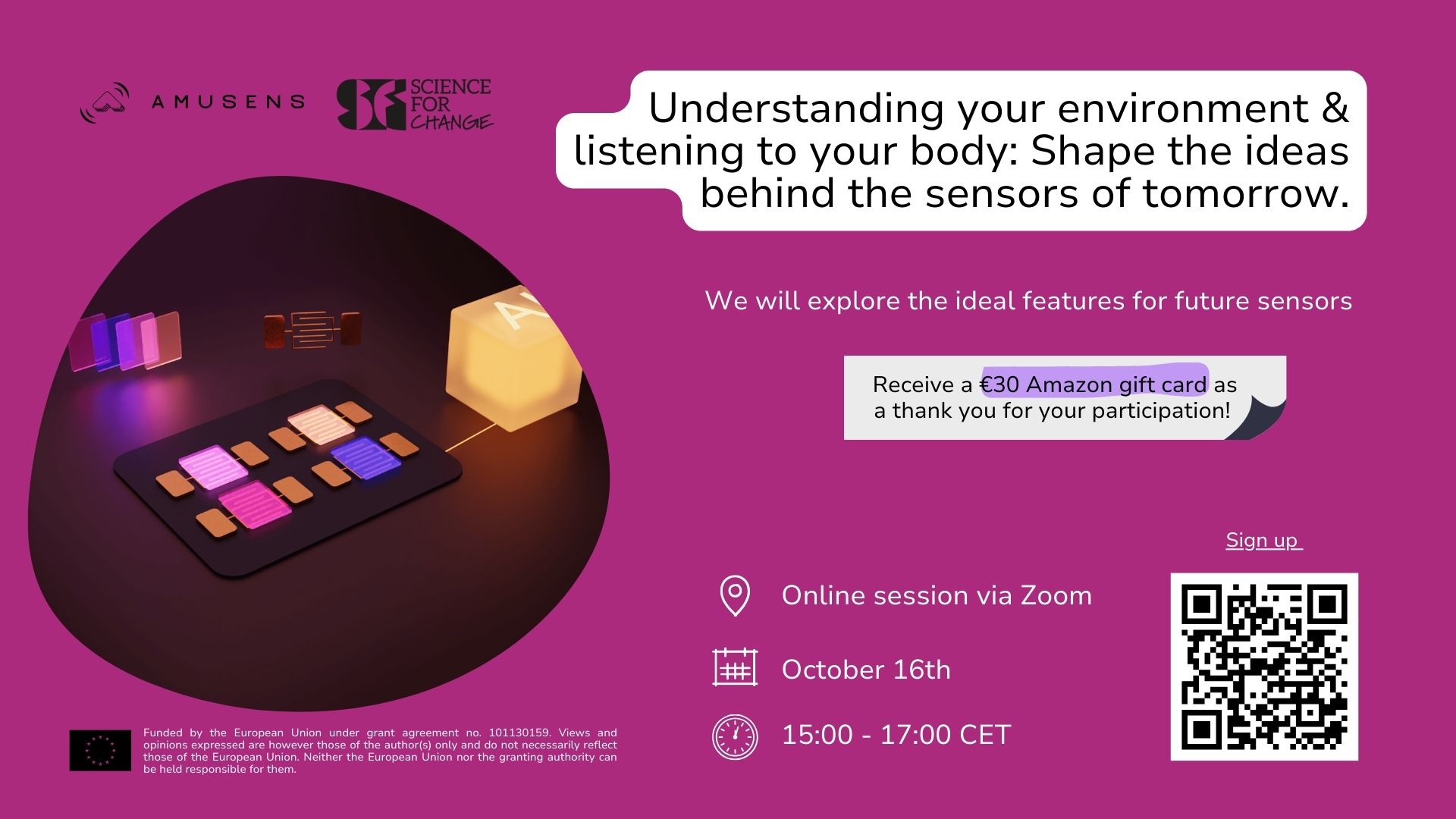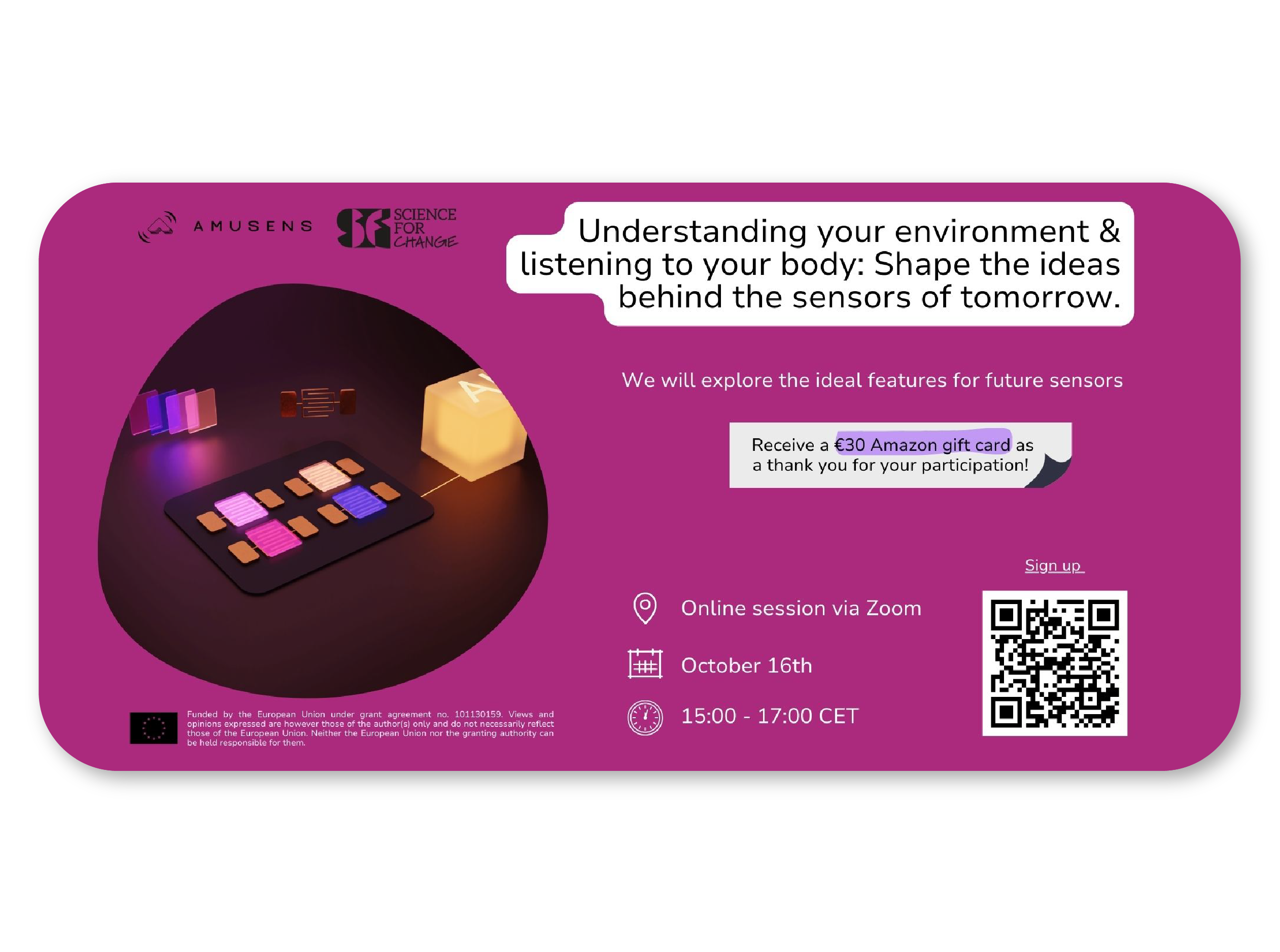On October 16, 2025, the AMUSENS project reached a crucial validation milestone by hosting its major European workshop, “Understanding your environment & listening to your body: Shape the ideas behind the sensors of tomorrow.” This online session was the third and final event in the project’s intensive user co-design phase. Held via ZOOM and the interactive MIRO platform, it brought together 22 participants from across Europe to validate, refine, and contrast user requirements identified in previous local workshops.
The AMUSENS project, funded by the European Union, aims to develop a versatile gas sensor platform combining a multi-pixel approach with artificial intelligence. This pan-European workshop uniquely focused on two distinct use cases: assessing Personal Exposure to pollutants and Breath Analysis for health monitoring. The objective was to identify shared needs (convergences) and specific requirements (divergences) for both, guiding the final technical development.
Gathering Europe’s Voices: The Participants
To ensure diverse, pan-European perspectives, a targeted recruitment campaign was launched. Invitations were sent to international contacts, disseminated through consortium partners’ networks, and promoted via official AMUSENS and Science For Change social media channels.
This effort gathered 22 participants, including members of the general public and key stakeholders from various European countries. They convened for the intensive two-hour online session, where they were arranged into two parallel groups—one for each use case—guided by dedicated facilitators from Science For Change.
A Structured Journey to Validation
The workshop was structured around five interactive dynamics deployed on a custom MIRO board. The session was designed to move from broad requirements to specific comparisons and final validation.
The core of the workshop was divided into five key phases:
- Dynamic 1: User Requirements Participants brainstormed ideal sensor features, voted on a predefined list of nine key requirements (like accuracy, comfort, and autonomy), and identified essential factors for building user trust.
- Dynamic 2: Empathy (User Journey) Using a guided map, the groups explored the end-to-end user experience—from setup to daily use. This helped identify emotions, potential challenges, and key moments for behaviour change.
- Dynamic 3: Validation Participants voted (Yes / Neutral / No) on key conclusions drawn from the previous local workshops. This dynamic served as a “stress test” to either confirm or challenge those earlier findings with a broader audience.
- Dynamic 4: Contrast This phase focused on a structured comparison, identifying convergences (shared needs across both use cases) and divergences (unique needs specific to either Personal Exposure or Breath Analysis).
- Dynamic 5: Final Discussion Each group held a plenary discussion to consolidate technical priorities, implementation challenges, and the potential real-world behavioural impact of the sensors.
Consolidating the Vision: Key Insights Gathered
The session successfully consolidated the project’s direction, revealing both a unified platform baseline and critical, distinct pathways for the two use cases.
Shared priorities emerged clearly: users across Europe demand sensors that are, above all, accurate, reliable, easy to use, and privacy-first. A compact, discreet, and app-centric design was universally favoured.
However, the validation confirmed crucial differences:
- For Personal Exposure, users prioritized comfort and battery autonomy for everyday, continuous wear.
- For Breath Analysis, users were willing to sacrifice comfort and autonomy for maximum accuracy and immediate, interpretable results. They emphasized the need for strict clinical-grade privacy and had zero tolerance for data monetization.
The workshop also identified two main user friction points: the complexity of initial setup/calibration and the “what next?” gap after receiving an alert, which requires actionable advice for exposure and professional interpretation for breath analysis.
Paving the Way for a Dual-Pathway Design
This final validation workshop was a vital step, ensuring the technology developed within AMUSENS is robustly aligned with a diverse, pan-European user base. The insights confirmed the need for a modular, dual-pathway architecture: a shared core technology (accurate, reliable, app-driven) complemented by specialized modules, privacy models, and user-guidance systems tailored for either environmental monitoring or personal health.
These consolidated requirements will now directly inform the project’s technical development.

